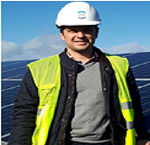Speakers
Javier Menndez Rodrguez
University of Oviedo SpainTitle: A comparative economic analysis between solar photovoltaic and woody biomass power plants
Abstract:
The use of renewable energies in the generation of electric power has increased considerably in the last years. The share of renewable energy sources in EU has increased from 16.97% to 30.75% in the period 2008-2017. The intermittent nature of some ways of renewable energies, such as wind and solar photovoltaic, requires flexible energy storage systems. Conversely, other renewable energy systems, such as forest biomass power plants provide dispatchable energy when needed. In addition, solid biomass may be used for: i) heating & cooling and hot water for domestic uses, ii) heating for industrial processes and iii) power generation. A comparative economic analysis between solar photovoltaic and biomass power plants is carried out in the present work. The energy produced by a solar photovoltaic power plant with 50 MWe of power reaches 80 GWh year.
Biography:
Javier Menendez received his MSc degree in Mining Engineering in 2005 and his PhD degree from the University of Oviedo, in Spain. He is manager at HUNASER ENERGY, a company dedicated to renewable energy sources. Previously he worked for one year at EDP energy and two years in an underground coal mine in NW Spain. Later, Javier Menendez worked for 11 years as project manager in an engineering company dedicated to energy and mining. His research covers the fields of hydropower, pumped-storage hydropower plants with underground reservoirs, solar photovoltaic power plants, geothermal energy with mine water and forest biomass power plants.
Maria Paula Cardeal Volpi
University of Campinas-UNICAMP BrazilTitle: Biogas production from the co-digestion of residues from 1G2G ethanol biorefinery: Electricity and biomethane
Abstract:
The debates on issues of global warming and reduction of greenhouse gases are common knowledge, and in this scenario, bioenergy gains strength and stands out as an efficient alternative. With the industrial development of the countries, an exponential increase in energy consumption will occur, and at the same time, energy demand will increase by an annual average of 1.6% by 2030 (Ghezloun et al., 2017). The importance of using biomass for power, heat, and fuel generation is increasing on a global scale. International and national policies, such as the European Action Plan for biomass and United Nations Conference on Climate Change (COP21) support the expansion of bioenergy, as they are considered climate-friendly compared to fossil fuels (Dressler et al., 2012). In this promising and challenging context, the production of biogas is returning to prominence and, consequently, has received numerous initiatives. Anaerobic digestion (AD), an attractive process for the management of liquid and solid waste that allows energy recovery through methane (CH4) and inside of AD, co-digestion have been highlighted since is an option to use poorly biodegradable substrates and providing and balancing macro and micronutrients for the AD process. Within the sugarcane biorefineries in Brazil, vinasse is a residue from the production of 1G ethanol, commonly used for the production of biogas (Fuess et al., 2017). And to increase the energy recovery of vinasse, this research was to did co-digest the vinasse together with the filter cake (another residue from the production of 1G ethanol) and the deacetylation liquor (residue from the production of 2G ethanol (Brenelli et al., 2020)). Within the co-digestion of these residues in a continuous semi-fed reactor, it was possible to obtain biogas production which, when converted into electrical energy, exceeds by 400% the amount of energy produced only with vinasse. Also, from this co-digestion, it is possible to obtain biomethane production that supplies the diesel-powered fleet (1.8×106 Nm3 month-1), and there is also a surplus of biogas that can be converted into electricity and has an installed capacity of 36 MW (Volpi et al., 2021). The co-digestion of residues from the production of 1G ethanol and residues from the production of 2G ethanol is quite efficient in terms of energy gains and may become an even more sustainable alternative for the sugar cane mills.
Biography:
Maria Paula Cardeal Volpi is biotechnologist graduated in 2016 from the Federal University of Sao Carlos, in Araras-São Paulo Brazil, with experience in bioprocesses. During her graduation she undertook scientific initiations with the development of research into fermentations using residues from the sugarcane industry to recover organic acids. In 2016-2018, she received a master's degree in chemical engineering, at the school of chemical engineering at the University of Campinas - UNICAMP.


